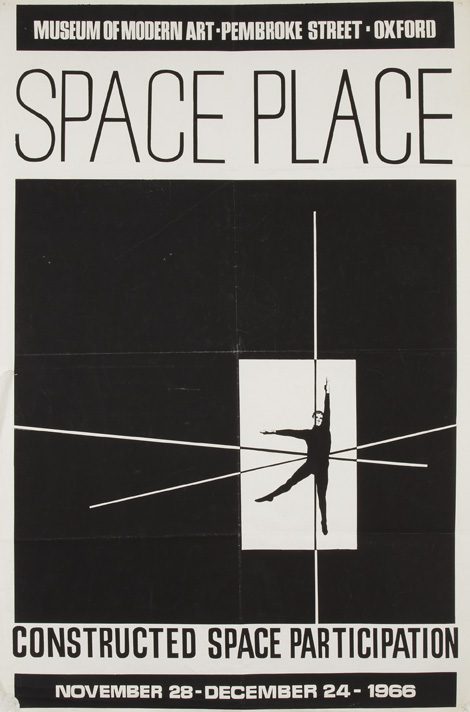Find out more about one of the earliest exhibitions at Modern Art Oxford, held in 1966. (Words by Hilary Floe.)
Space Place: Constructed Space Participation was held at the Museum of Modern Art, Oxford from 28 November to 24 December 1966.

The Museum of Modern Art Oxford (MOMA) founder and architect Trevor Green selected Maurice Agis and Peter Jones’ installation Space Place: Constructed Space Participation as MOMA’s first self-generated exhibition.
In the words of art critic Andrew Forge, the exhibition declared the director’s intention to make the museum ‘a place where things can happen… music can be played or children can run about, people can talk.’ Forge’s review favourably contrasted the installation with so-called ‘gallery art’, with its associations of dullness and elitism. Like MOMA itself, Space Place was for ‘real people in real places.’
In terms of its physical appearance, Space Place was a geometrical installation in bright primary hues. Square and rectangular planes of blue, red and green defined a three-dimensional space, set against or jutting out from walls partially covered in black fabric and lit by a large light box. Poles of blue and yellow shot through them at right angles, ending abruptly in mid-air.

Agis and Jones had trained as artists at St. Martin’s in the early 1960s. They originally conceived the work in a Fulham basement in 1964, spending a year transforming a decrepit carpenter’s workshop into Space Place’s first incarnation. In Oxford, the materials were mostly newly developed synthetics, such as viscotex and lamithane, all donated by industrial sponsors including Pfizer Limited.
The museum went to considerable lengths to ensure that Agis and Jones’ geometrical installation in primary colours be seen not as a finished piece for contemplation but as an incitement to further creativity.

Space Place was conceived as an environment for personal interaction, rather than as an arrangement of solemn attention in its own right. And yet the artists’ ambitions for the piece were far from modest: their design for the gallery claimed to offer a ‘total experience’ that could reverse the alienation of ‘man from man and man from his nature.’
The visual experience was supplemented by a taped soundtrack of ‘hoots and booms,’ and the museum invited a distinguished succession of experimental artists and musicians to perform within the gallery. Yoko Ono enacted Tao kōans, Adrian Mitchell recited anti-war poetry, and John Tilbury performed an action with a piano and some beans to a youthful ‘bearded, jeaned and bell-bottomed audience.’ Typically for the museum in this period, none of these events were documented, although Tillbury’s performance was registered a local reporter who commented ‘perhaps it was a happening at the Oxford Museum of Modern Art last night, because certain things happened, though it’s hard to explain exactly what.’

–
Hilary Floe, The Museum of Modern Art, Oxford (1965-1982): Exhibitions, Spectatorship and Social Change, Doctoral Thesis, 2016.
